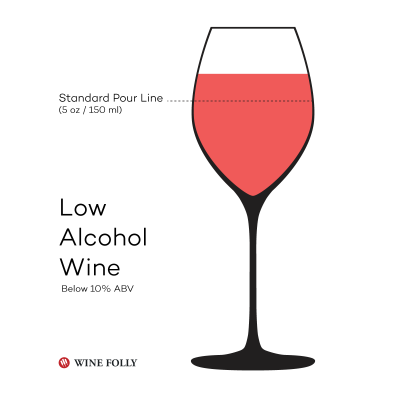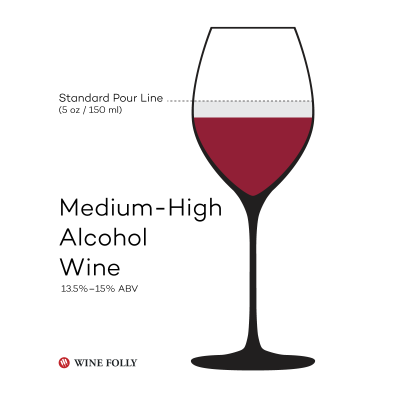It’s a little known fact that the world’s largest wine producer, E. J.Gallo, built their empire off the success of their white wine called Thunderbird. The wine was originally designed to appeal to a young market and has now garnered cult status as a “bum wine.”
The Lightest to the Strongest Wine
Why was Thunderbird such a success? Well, simply put it has 20% alcohol by volume (ABV). Let’s take a look at alcohol levels are in wine from the lightest to the strongest. Truth be told, alcohol content in wine ranges wildly from as low as 5.5% to 23% ABV. There are several factors that affect the alcohol content of wine including the style of wine, quality level, and climate where the grapes grow.

How much wine should we be drinking?
The rule of thumb is that a glass of wine is worth one standard drink and women get one of these a night and men get two. However, this makes the assumption that the wine is only 12% ABV. So if you’re drinking a high-alcohol wine like Port or Thunderbird (at 20% ABV), the recommended serving size is about half. Yep, sometimes it’s better to get a lower alcohol wine, especially if you love to drink.
You can drink more light-alcohol wine with the same effect as one glass of high-alcohol wine.
Low Alcohol Wines
Under the 10% ABV level, most wines will be light in body and sweet. German Kabinett Riesling (at 8% ABV) and Italian Moscato d’Asti (at 5.5% ABV) are typical examples of light-alcohol wines.
The reason why these wines tend to be sweet is from the leftover grape sugar in the wine after the desired alcohol-level is reached. Leftover sweetness in wine is called residual sugar (RS) and comes from the sweetness of grapes at harvest time.
Examples
- Moscato d’Asti 5.5% ABV (lightly sparkling sweet white from Italy)
- Brachetto d’Acqui 6.5% ABV (lightly sparkling sweet red from Italy)
- Kabinett Riesling 8% ABV (light sweet German Riesling)
- Spätlese Riesling 8.5% ABV (rich sweet German Riesling)
- Alsace Blanc 9%–10% ABV (France)
- Muscadet 9.5% ABV (France)
NOTE: Looking for low alcohol, low calorie dry wines? Read this
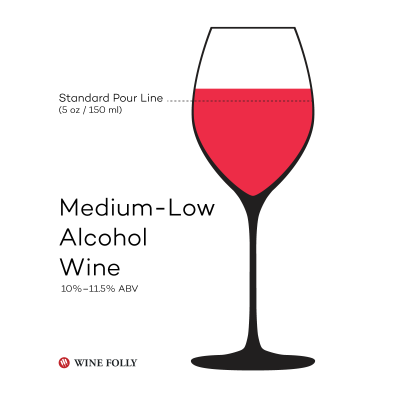
Medium-Low Alcohol Wines
Wines ranging from 10–11.5% ABV are usually produced when less-sweet grapes are used to make wine. It’s pretty common to see white wines with medium-low alcohol from cooler climate regions like France, Northern Italy and Germany.
There are also several sparkling wines in this alcohol content category because the wine producers pick the grapes a little earlier in the season to insure that the wines stay zesty with higher acidity to compliment the bubbles.
Examples
- Muscadet (France)
- Touraine and Cheverny (Sauvignon Blanc from Loire, France)
- Lambrusco (Italy)
- Soave (Italy)
- Gavi (an Italian wine region that produces white wines with Cortese grapes.)
- Pinot Grigio (Italy)
- Grüner Veltliner (Austria)
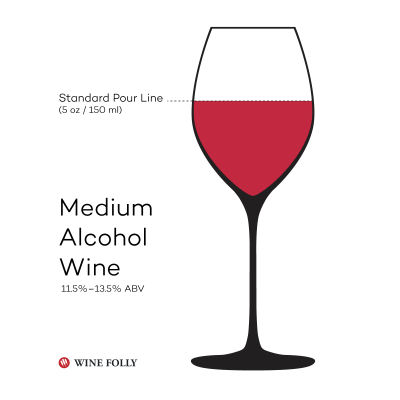
Medium Alcohol Wines
If you live in the US, you might believe that these numbers seem a little low, but for the rest of the world 11.5%–13.5% ABV is the average. In fact, the US standard serving of wine is a glass (5 oz) of medium alcohol-content wine.
Most European wines will be in this range, as well as American bargain wines.
Examples
- Bordeaux (Cabernet-Merlot blend from France)
- Bourgogne (Pinot Noir or Chardonay from France)
- Champagne (France)
- Côte du Rhône (France)
- Beaujolais (France)
- Chianti (Italy)
- Dolcetto (Italy)
- Barbera (Italy)
- Nebbiolo (Italy)
- Rosé Wine
- Sauvignon Blanc (California)
- Value Reds (California)
- Red Wines (Chile)
- Riesling (Washington)
- Pinot Gris and Pinot Noir (Oregon)
TIP: The higher the alcohol, the bolder and richer the wine will taste.
Medium-High Alcohol Wines
This is the average range of dry American wines and other warm climate growing regions including Argentina, Australia, Spain and Southern Italy. Regions with warmer climates will produce sweeter grapes which in turn increases the potential alcohol content of the wine.
Examples
- Chardonnay (California and Washington)
- Viognier (California)
- Petite Sirah (California)
- Pinot Noir (California)
- Cabernet Sauvignon and Merlot (California and Washington)
- Zinfandel (California)
- Grenache aka Garnacha (Spain and Australia)
- Shiraz (Australia)
- Pinotage (South Africa)
- Malbec (Argentina)
- Barolo (Italy)
- Amarone della Valpolicella (Italy)
- Brunello di Montalcino (Italy)
- Nero d’Avola (Italy)
- Châteauneuf-du-Pape (France)
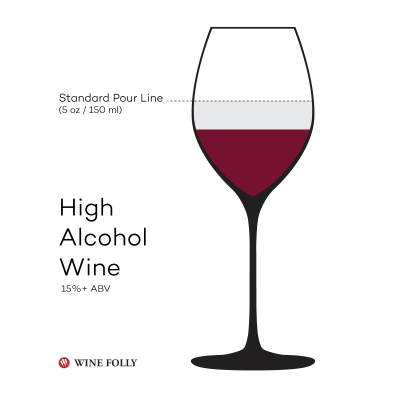
High Alcohol Wines
High alcohol wines are made one of two possible ways: naturally or with fortification. Fortified wine is when a neutral spirit (usually a distilled grape brandy) is added to wine to increase the alcohol content.
The original purpose for fortifying wine was to preserve the flavor of wines during the age of exploration. High alcohol dessert wines like Port, Marsala, Madeira and Sherry are commonly fortified and so are aromatized wines (aka vermouth).
It’s more rare to find a natural high alcohol wine, but they do exist, thanks to science!
Examples
- Shiraz ~15.5% ABV (Australia)
- Grenache-Syrah-Mourvèdre 15.5% ABV (California and Australia)
- Zinfandel up to 16% ABV (California)
- Late Harvest Dessert Wine 15–17% ABV
- Sherry 15–20% ABV (Spain)
- Port and Tawny Port ~20% ABV (Portugal)
- Banyuls and Maury ~20% ABV (France)
- Madeira ~20% ABV (Portugal)
- Marsala ~20% ABV (Sicily)
- Aromatized Wine (Vermouth) 20% ABV
- Other Fortified Wines
TIP: A wine that is described as “hot” means it has high alcohol content..

Have Wines Become More Alcoholic?
Yes.
The reason why wine has become naturally higher in alcohol has a lot to do with science. For example, back in the 1950’s the yeast would not survive in alcohol levels too much higher than 13.5% ABV. In fact, it was common to get a “stuck fermentation” where yeasts would die before all the sugar in the grape juice had been converted into alcohol (This is how white zin was invented!).
Today however, we’ve developed very resilient yeasts that can survive in alcohol levels as high as 16.5% ABV. This also might be why we’re seeing more high alcohol beers than ever before.
Another reason that seems viable has to do with climate change. The more ripe and sweet the grape, the higher the alcohol by volume (because yeast converts sugar into alcohol). Of course, this is a little harder to prove because there are many variables.
Suffice to say, if it’s over 14% ABV, be careful with your portion size, it catches up with you fast!

